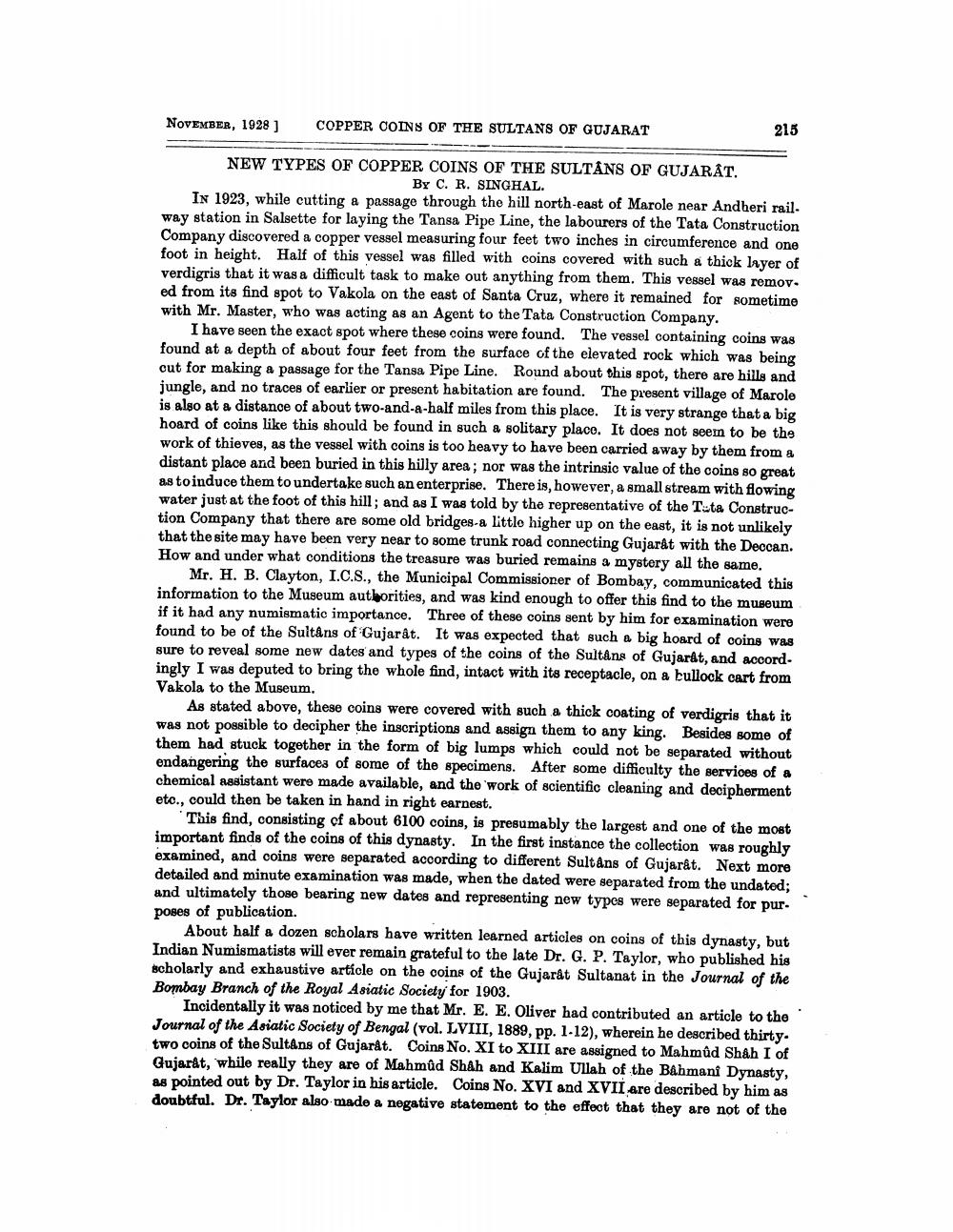________________
NOVEMBER, 1928)
COPPER COINS OF THE SULTANS OF GUJARAT
215
NEW TYPES OF COPPER COINS OF THE SULTANS OF GUJARAT.
BY C. R. SINGHAL. In 1923, while cutting a passage through the hill north-east of Marole near Andheri rail. way station in Salsette for laying the Tansa Pipe Line, the labourers of the Tata Construction Company discovered a copper vessel measuring four feet two inches in circumference and one foot in height. Half of this vessel was filled with coins covered with such a thick layer of verdigris that it was a difficult task to make out anything from them. This vessel was remov. ed from its find spot to Vakola on the east of Santa Cruz, where it remained for sometime with Mr. Master, who was acting as an Agent to the Tata Construction Company.
I have seen the exact spot where these coins were found. The vessel containing coins was found at a depth of about four feet from the surface of the elevated rock which was being cut for making a passage for the Tansa Pipe Line. Round about this spot, there are hills and jungle, and no traces of earlier or present habitation are found. The present village of Marole is also at a distance of about two-and-a-half miles from this place. It is very strange that a big hoard of coins like this should be found in such a solitary place. It does not seem to be the work of thieves, as the vessel with coins is too heavy to have been carried away by them from a distant place and been buried in this hilly area; nor was the intrinsic value of the coins so great as toinduce them to undertake such an enterprise. There is, however, a small stream with flowing water just at the foot of this hill; and as I was told by the representative of the Tota Construction Company that there are some old bridges a little higher up on the east, it is not unlikely that the site may have been very near to some trunk road connecting Gujarat with the Deocan. How and under what conditions the treasure was buried remains a mystery all the same.
Mr. H. B. Clayton, I.C.S., the Municipal Commissioner of Bombay, communicated this information to the Museum authorities, and was kind enough to offer this find to the museum if it had any numismatic importance. Three of these coins sent by him for examination were found to be of the Sultans of Gujarat. It was expected that such a big hoard of coins was sure to reveal some new dates and types of the coins of the Sultâne of Gujarat, and accord. ingly I was deputed to bring the whole find, intact with its receptacle, on a bullock cart from Vakola to the Museum.
As stated above, these coins were covered with such a thick coating of verdigris that it was not possible to decipher the inscriptions and assign them to any king. Besides some of them had stuck together in the form of big lumps which could not be separated without endangering the surfaces of some of the specimens. After some difficulty the servioes of a chemical assistant were made available, and the work of scientific cleaning and decipherment etc., could then be taken in hand in right earnest.
This find, consisting of about 6100 coins, is presumably the largest and one of the most important finds of the coins of this dynasty. In the first instance the collection was roughly examined, and coins were separated according to different Sultans of Gujarat. Next more detailed and minute examination was made, when the dated were separated from the undated; and ultimately those bearing new dates and representing new types were separated for pur. poses of publication.
About half a dozen scholars have written learned articles on coins of this dynasty, but Indian Numismatists will ever remain grateful to the late Dr. G. P. Taylor, who published his scholarly and exhaustive article on the coins of the Gujarat Sultanat in the Journal of the Bombay Branch of the Royal Asiatic Society for 1903.
Incidentally it was noticed by me that Mr. E. E. Oliver had contributed an article to the Journal of the Asiatic Society of Bengal (vol. LVIII, 1889, pp. 1-12), wherein he described thirty. two coins of the Sultans of Gujarat. Coins No. XI to XIII are assigned to Mahmûd Shah I of Gujarat, while really they are of Mahmûd Shah and Kalim Ullah of the Bahmani Dynasty, as pointed out by Dr. Taylor in his article. Coins No. XVI and XVII are described by him as doubtful. Dr. Taylor also made a negative statement to the effect that they are not of the




